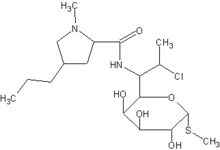Ugwumadu A, Manyonda I, Reid F, Hay P. Effect of early oral clindamycin on late miscarriage and preterm delivery in asymptomatic women with abnormal vaginal flora and bacterial vaginosis: a randomized controlled trial. Lancet 2003; 361:983-988.
* PRACTICE RECOMMENDATIONS
Using oral clindamycin to treat women with asymptomatic bacterial vaginosis during their second trimester (between 12 and 22 weeks estimated gestational age) reduces the number of premature births and late miscarriages. The study did not demonstrate a difference in the number of neonatal intensive care unit admissions, mean birth weight, or gestational age.
This is the first study demonstrating benefits in treating asymptomatic bacterial vaginosis early in pregnancy. It still needs to be determined, in larger trials, whether generalized screening and treatment for asymptomatic bacterial vaginosis in the early second trimester is beneficial and cost-effective.
* BACKGROUND
Bacterial vaginosis is associated with premature delivery and late miscarriage. In 2 previous randomized controlled trials, metronidazole did not reduce preterm delivery in low-risk pregnancies when used to treat bacterial vaginosis at 23 to 24 weeks estimated gestational age. Another randomized controlled trial showed an 18% absolute risk reduction in premature deliveries when metronidazole and erythromycin were used to treat bacterial vaginosis in pregnant women with preexisting risk factors for premature delivery. (1)
This study set out to determine whether treating bacterial vaginosis earlier (before 22 weeks estimated gestational age) with oral clindamycin would reduce the number of premature births and late miscarriages.
* POPULATION STUDIED
This British, 2-center study enrolled 6120 of 11,189 pregnant women in their early second trimester--between 12 and 22 weeks estimated gestational age--who agreed to screening for bacterial vaginosis or abnormal vaginal flora. Slides were gram-stained, and 2 independent investigators assessed the slides with the Nugent scoring system (0-10).
The investigators excluded 246 of 740 women who had a positive screening test because of various reasons, including symptomatic bacterial vaginosis; age <16 years; multiple gestations; had or needed cervical cerclage or cone biopsy; demonstration of a cervical, uterine, or fetal anomaly; diabetes mellitus, hypertension, or collagen vascular disease.
* STUDY DESIGN AND VALIDITY
The 494 women who met diagnostic criteria for bacterial vaginosis or abnormal vaginal flora were randomly assigned by computer to receive either clindamycin 300 mg orally twice daily for 5 days or matching placebo. Allocation was concealed, and the study was double-blinded.
The women were followed-up in clinic 2 to 4 weeks after treatment to assess side effects and pregnancy status. Data were extracted from hospital records for the outcomes.
The methodology was very strong. Strengths include randomization, double-blinding, power for primary outcome of 90%, sufficient follow-up rate, and sensitivity analysis for 9 lost follow-ups.
Weaknesses were relatively minor, and included lack of power for secondary outcomes and a mild imbalance between treatment and placebo group. The placebo group had a slightly increased history of previous miscarriages (primarily first trimester) but not preterm deliveries. The authors postulated that this discrepancy was not likely to affect the overall results because a history of first-trimester miscarriage does not increase the risk of future premature delivery or late miscarriage.
* OUTCOMES MEASURED
The primary endpoint of the study was the number of late miscarriages (between 13 and 24 weeks gestation) and preterm deliveries (between 24 weeks and 37 weeks gestation). Secondary outcomes included admission to neonatal intensive care unit, birth weight, and number of weeks gestation at delivery.
* RESULTS
Women treated with clindamycin had a statistically significant reduced rate of late miscarriages or spontaneous preterm deliveries compared with women in the placebo group (5.3% vs 15.8%). Ten (95% confidence interval, 6-20) women positive for bacterial vaginosis would need to be treated to prevent 1 late miscarriage or preterm delivery.
Overall, 120 women would need to be screened, with all women treated who were positive for bacterial vaginosis, to prevent 1 of these outcomes. There was no statistically significant difference in mean birth weight, gestational age at delivery, or need for admission to the neonatal intensive care unit. The small sample size of the study limited its power to show a possible statistically significant difference in the secondary outcomes.
REFERENCE
(1.) Hauth JC, Goldenberg RL, Andrews WW, et al. Reduced incidence of preterm delivery withmetronidazole and erythromycin in women with bacterial vaginosis. N Engl J Med 1995; 333:1732-1736.
Aimo Berger, MD, and Kevin Y. Kane, MD, MSPH, Department of Family Medicine, University of Missouri-Columbia. E-mail: bergera@health.missouri.edu.
COPYRIGHT 2003 Dowden Health Media, Inc.
COPYRIGHT 2003 Gale Group



